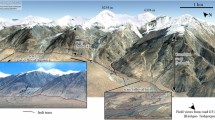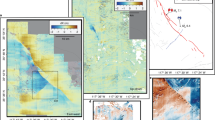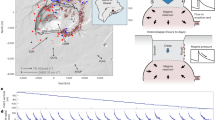Abstract
The active fault traces on which earthquakes occur are generally not continuous1, and are commonly composed of segments that are separated by discontinuities that appear as steps in map-view. Stress concentrations resulting from slip at such discontinuities may slow or stop rupture propagation and hence play a controlling role in limiting the length of earthquake rupture2. Here I examine the mapped surface rupture traces of 22 historical strike-slip earthquakes with rupture lengths ranging between 10 and 420 km. I show that about two-thirds of the endpoints of strike-slip earthquake ruptures are associated with fault steps or the termini of active fault traces, and that there exists a limiting dimension of fault step (3–4 km) above which earthquake ruptures do not propagate and below which rupture propagation ceases only about 40 per cent of the time. The results are of practical importance to seismic hazard analysis where effort is spent attempting to place limits on the probable length of future earthquakes on mapped active faults. Physical insight to the dynamics of the earthquake rupture process is further gained with the observation that the limiting dimension appears to be largely independent of the earthquake rupture length. It follows that the magnitude of stress changes and the volume affected by those stress changes at the driving edge of laterally propagating ruptures are largely similar and invariable during the rupture process regardless of the distance an event has propagated or will propagate.
This is a preview of subscription content, access via your institution
Access options
Subscribe to this journal
Receive 51 print issues and online access
$199.00 per year
only $3.90 per issue
Buy this article
- Purchase on Springer Link
- Instant access to full article PDF
Prices may be subject to local taxes which are calculated during checkout



Similar content being viewed by others
References
Wesnousky, S. Seismological and structural evolution of strike-slip faults. Nature 335, 340–343 (1988)
Segall, P. & Pollard, D. D. Mechanics of discontinuous faults. J. Geophys. Res. 85, 4337–4350 (1980)
King, G. C. P. & Nabelek, J. F. Role of fault bends in the initiation and termination of earthquake rupture. Science 228, 984–987 (1985)
Barka, A. & Kadinsky-Cade, K. Strike-slip fault geometry in Turkey and its influence on earthquake activity. Tectonics 7, 663–684 (1988)
Schwartz, D. P. & Sibson, R. H. Fault Segmentation and Controls of Rupture Initiation and Termination (United States Geological Survey, USGS open-file report 89-315, Proc. Conf. XLV, Palm Springs, California, 1989)
Zhang, P., Slemmons, D. B. & Mao, F. Geometric pattern, rupture termination, and fault segmentation of the Dixie Valley-Pleasant Valley active normal fault systems, Nevada. USA J. Struct. Geol. 13, 165–176 (1991)
Sibson, R. H. Stopping of earthquake ruptures at dilational fault jogs. Nature 316, 248–251 (1985)
Sibson, R. H. in Earthquake Source Mechanics 157–167 (American Geophysical Union, Washington DC, 1986)
Harris, R. A. & Day, S. M. Dynamics of fault interaction—parallel strike-slip faults. J. Geophys. Res. 18, 4461–4472 (1993)
Harris, R. A. & Day, S. M. Dynamic 3D simulations of earthquakes on en echelon faults. Geophys. Res. Lett. 98, 2089–2092 (1999)
Oglesby, D. D. The dynamics of strike-slip step-overs with linking dip-slip faults. Bull. Seismol. Soc. Am. 95, 1604–1622 (2005)
Harris, R. A., Archuleta, R. J. & Day, S. M. Fault steps and the dynamic rupture process: 2-D numerical simulations of a spontaneously propagating shear fracture. Geophys. Res. Lett. 18, 893–896 (1991)
Harris, R. A., Dolan, J. F., Hartleb, R. & Day, S. M. The 1999 Izmit, Turkey earthquake—A 3D dynamic stress transfer model of intraearthquake triggering. Bull. Seismol. Soc. Am. 92, 245–255 (2002)
Kase, Y. & Kuge, K. Numerical simulation of spontaneous rupture processes on two non-coplanar faults: the effect of geometry on fault interaction. Geophys. J. Int. 135, 911–922 (1998)
Brace, W. F. & Kohlstedt, D. L. Limits on lithospheric stress imposed by laboratory experiments. J. Geophys. Res. 85, 6248–6252 (1980)
Graymer, R. W., Langenheim, V. E., Simpson, R. W., Jachens, R. C. & Ponce, D. A. Relatively simple throughgoing fault planes at large earthquake depth may be concealed by surface complexity in stepover regions. In Tectonics of Strike-slip Restraining and Releasing Bends (eds Cunningham, D. & Mann, P.) (Geological Society of London Special Volume, in the press).
Simpson, R. W., Barall, M., Langbein, J., Murray, J. R. & Rymer, M. J. San Andreas fault geometry in the Parkfield, California region. Bull. Seismol. Soc. Am. 96, S28–S37 (2006)
Bodin, P. & Brune, J. N. On the scaling of slip with rupture length for shallow strike-slip earthquakes: Quasi-static models and dynamic rupture propagation. Bull. Seismol. Soc. Am. 86, 1292–1299 (1996)
Heaton, T. H. Evidence for and implication of self-healing pulses of slip in earthquake rupture. Phys. Earth Planet. Inter. 64, 1–20 (1990)
McCann, W. R., Nishenko, S. P., Sykes, L. R. & Krause, J. Seismic gaps and plate tectonics: seismic potential for major boundaries. Pure Appl. Geophys. 117, 1082–1147 (1979)
Acknowledgements
I thank J. Dolan, R. Dmowska, R. Harris, B. Oglesby and B. Shaw for comments or reviews when developing the manuscript. Research was supported in part by a USGS NHERP contract and an NSF/SCEC award.
Author information
Authors and Affiliations
Corresponding author
Ethics declarations
Competing interests
Reprints and permissions information is available at www.nature.com/reprints. The author declares no competing financial interests.
Supplementary information
Supplementary Notes 1
DESCRIPTION GOES HERE (DOC 117 kb)
Supplementary Notes 2
DESCRIPTION GOES HERE (JPG 126 kb)
Supplementary Notes 3
DESCRIPTION GOES HERE (JPG 149 kb)
Supplementary Notes 4
DESCRIPTION GOES HERE (JPG 149 kb)
Supplementary Notes 5
DESCRIPTION GOES HERE (JPG 157 kb)
Rights and permissions
About this article
Cite this article
Wesnousky, S. Predicting the endpoints of earthquake ruptures. Nature 444, 358–360 (2006). https://doi.org/10.1038/nature05275
Received:
Accepted:
Issue Date:
DOI: https://doi.org/10.1038/nature05275
This article is cited by
-
FRS (Fault Rating System): a quantitative classification of active faults for hazard evaluations
International Journal of Earth Sciences (2024)
-
Diverse slip behaviour of velocity-weakening fault barriers
Nature Geoscience (2023)
-
The Menyuan, Qinghai MS6.9 Earthquake on January 8, 2022: A Strike-slip Cascading Rupture Event
Pure and Applied Geophysics (2023)
-
Complex trans-ridge normal faults controlling large earthquakes
Scientific Reports (2022)
-
Complex seismic image of the Main Himalayan Thrust in Garhwal and implication to earthquake hazard
Journal of Earth System Science (2022)
Comments
By submitting a comment you agree to abide by our Terms and Community Guidelines. If you find something abusive or that does not comply with our terms or guidelines please flag it as inappropriate.



